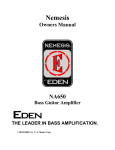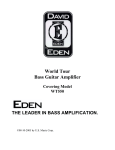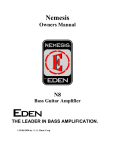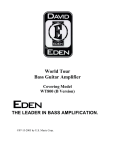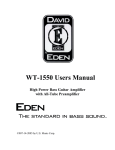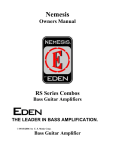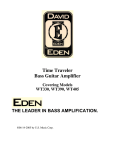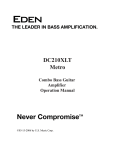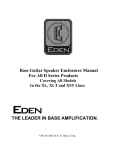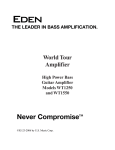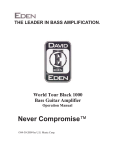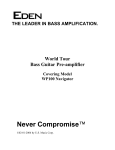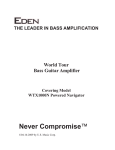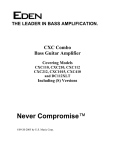Download Eden VT-300B Operating instructions
Transcript
VT-300B Valve Tech All-Tube Bass Guitar Amplifier Operation Manual THE LEADER IN BASS AMPLIFICATION. ©06-20-2005 by U.S. Music Corp. FOREWORD Congratulations on the purchase of your new Eden VT-300B all-tube Integrated Amplifier System. All of us at Eden are totally committed to providing you with the very best bass guitar systems in their class. Our goals are to offer you the outstanding performance quality of a top-notch, professional bass amplification system at a reasonable price point, and to make the most musical and reliable Bass amplifiers available. This manual will cover all domestic and international versions of the VT-300B. The VT-300B was designed for those who love the great vintage tone and gentle acoustic color of the old tube amplifiers. This is a hand-crafted amplifier built with modern construction techniques and reliable printed circuits by people who care about sound and quality. You have purchased what we feel is one of the finest bass amplifiers in the world. This rack mountable package houses modular circuits made with superior components and designed for years of trouble-free service. Your amplifier was designed, engineered and manufactured equivalent to aircraft vibration standards and housed in a one-piece aluminum case with steel top to ensure maximum reliability. The PCB design allows quick repair in the field should such a need arise. Just as a skilled craftsman needs good quality tools that won't let him down on the job, so does a good musician. We hope you enjoy the tool we’ve created. Have fun; play low! Please read this manual in its entirety before operating your new amplifier. Failure to do so could result in misuse or damage. We’ve taken the time to write it, which was a lot longer than the time it will take for you to read it. Help us help you by taking a few moments to learn how to properly use your new amp. You’ll be glad you did! Please complete for your records: Date of Purchase: __________________________ Model: ___________________________________ Serial Number: _____________________________ Dealer: ___________________________________ 2 CAUTION! Your ears are your most important piece of equipment. Unfortunately, they cannot be replaced as easily as your other gear. Please take the following warning seriously. This product, when used in combination with loudspeakers and/or additional amplification may be capable of producing sound levels that could cause permanent hearing loss. DO NOT operate at high volume levels or at a level that is uncomfortable. If you experience any discomfort or ringing in the ears or suspect hearing loss, you should consult an audiologist. Thank you for your purchase of an Eden bass guitar product. This unit has been designed and constructed to give you years of trouble-free service. Please take the time to review this manual and to send in your warranty registration card. 3 FRONT PANEL FEATURES Input Jacks – Designed to accept a standard _” mono phone plug. The Passive jack is for use with low output basses and passive basses. The active jack is for higher output basses with active electronics. Overdrive Switch – This switch shifts the amplifier into an ultra-high gain mode, suitable for a wide range of sound textures – from clean to fat and all the way to saturated – with exact control throughout the entire range. This works in conjunction with the Input Gain control. The higher the Input Gain control is set, the more distortion can be generated. This function is also on the foot switch. Gain Control – This sets the channel gain for the system and lets you match the output level of your instrument to the amplifier. In the Overdrive mode the Gain Control setting determines the amount of overdrive available. Multi Q Equalizer – The Multi Q Equalizer circuit uses a four band parametric E.Q. It has preset centers, and fixed Qs or bandwidths that vary with center frequency. This is a very user-friendly set up. You can fine tune your sound very quickly using this simple system. The center frequency spacing follows the natural content of the music and fits with the instrument very well. Master Tone Controls – The Master Bass and Treble controls are provided for very fast E.Q. of the system. They also combine with the Multi Q for even more tone shading. These are Hi-Fi-type shelving filters and effect a broad range of tone. Master Level Control – This controls the final drive to the amplifier. Use this to control your stage level. About mid point on the control should be normal for most playing situations. Compressor Active light – This indicates the activity of the compressor. When the LED lights up the compressor is functioning. Standby – This switch sets the amplifier in the standby mode. The filaments stay powered up but the hi voltage to the output tubes is removed so that they can not operate. This extends the life of the tube and allows for less stress during start up and power down. 4 Mains On/Off – This turns the main power to the amplifier ON and OFF. BACK PANEL FEATURES AC Power Inlet – This is the main AC connection point. It is an IEC type inlet and also serves as the fuse carrier. Replace the fuse only with the same type and size as the original. FX Loop – This loop is located post the tone controls and is just prior to the amplifier input. Tuner Output – This provides a full-time output for connection to a tuner. Direct Recording Output – The direct recording output is fully balanced and has the ground lifted as the standard configuration. It is configured for both Pre and Post tone with the provided switch. The output level can be adjusted with the level control positioned next to the pre/post switch. Speaker Impedance Selector – This switch should be selected to match the impedance of the enclosure. Note: This should be done with the Amplifier turned OFF. Speaker Output Connectors – Connect the loudspeaker here. Connect the speaker before turning on the amplifier. Do not disconnect the speaker while the power is on. IMPORTANT NOTE: Do NOT use your VT-300B without a speaker load. Doing so will cause damage. Running this amp without a speaker load is a VERY BAD THING. Don’t do it. Ever. Remember, this is a vacuum tube amplifier, not a solid state amplifier. Cooling System – This unit uses a continuous flow cooling system that is always in operation when the power is on to the amplifier. IMPORTANT NOTE: Excessive heat is a Very Bad Thing and can result in severe damage to your amplifier. DO NOT bypass or disconnect any part of your thermal safety system. Doing so will immediately void your warranty! 5 Output Tubes – Your unit comes from the factory set up and fully run in for 6550 type output tubes. Replacement tubes that match your output tubes are available from the factory. Look up the number on you output tubes and ask for the same code number. You can generally replace one or two numerically matched tubes without re-biasing the amplifier. A full replacement set should always be re-biased by a qualified technician. High quality, matched output tubes will have better output power and longer service life than will a poorly matched set. FOOTSWITCH FEATURES Compressor/Limiter –Engages the Compressor/Limiter in the final output stage of the amplifier. Damping Selector – This unique feature is on the foot switch of the current (A) model. It allows the amplifier to be very flexible. In the Low setting, you get normal vacuum tube damping response. This provides an open, round, soft low end that works well with 4 string Basses and traditional tones. In the High position you get a tighter, more defined sound suitable for slapping and more modern playing styles. EQ Bypass – Completely bypasses the EQ section. Overdrive – Duplicates the Overdrive switch on the front panel. Mute – Mutes all outputs except the Tuner Out. OPERATING INSTRUCTIONS Mechanical and Thermal Issues – During operation, your amplifier should always be placed away from sources of moisture or heat. Care should be taken not to obstruct the ventilation holes on the unit. The integral rack ears can be used to install your amplifier in a conventional equipment rack for protection during transportation. Electrical Connection – The VT-300B requires at least 10 Amps of correctly wired alternating current for proper operation. Providing less than 10 Amps of power may result in poor amplifier performance and bad tone, so it’s probably not a good idea to plug all of your band’s gear into a single wall outlet. 6 Connections – All instrument-level input connections (everything but the speakers) should be made with high quality shielded cables. The use of speaker cables for input connections will result in excess noise. Speaker connections should be made with high quality 16 gauge or heavier unshielded speaker cables. We recommend 10 or 12 gauge cables. The use of shielded line or instrument cables for speaker connections can damage your amplifier. The speaker cable should be as short as possible. REPEAT IMPORTANT NOTE: Do NOT use your VT-300B without a speaker load. Doing so will cause damage. Running this amp without a speaker load is a VERY BAD THING. Don’t do it. Ever. INITIAL SET UP As bassists, each of us has in our head a concept of our perfect sound. Eden amplifiers are designed to help you easily achieve the sound you hear inside you. However, it’s a multi-step process as explained below. In order to ensure the ultimate in tone, it’s important to follow the procedure outlined below. Don’t skip steps; don’t jump around. Yes, this may take a minute or two, but the work is well worth it. Once they’ve done it a few times, most users can do it time and again in about a minute. IMPORTANT NOTE: Before you plug in your unit for the first time, please do the following things. First, turn the power switch to the OFF position. Check the back of your unit for the correct voltage notation for your county of operation. Confirm that the Speaker Impedance selector switch is in the proper position. AND CONNECT A SPEAKER TO THE AMPLIFIER. Once you’ve ensured correct voltage, set the Master Volume control to minimum (fully counter-clockwise). Set the tone controls to the center position (12:00 or 0). Set the Input Gain control to the minimum (fully counter-clockwise). Set the Compressor/Limiter to the OFF position. This will set your amplifier up flat and with the Compressor/Limiter disengaged. Next, plug in the power cord to the AC inlet on the back of the unit. Use only a safe, grounded receptacle for proper operation at the correct voltage for your country. Double check to make certain your amplifier is set for the correct voltage in your country, and for proper speaker impedance. Confirm that there is a speaker connected to the amplifier. 7 Turn On – Once you’ve completed the steps above, you can plug in your bass and turn on the unit (plug it in first, ok?) and let’s get started. Turn the Mains switch to ON. Wait approximately 30 seconds to one minute and then turn Standby switch to ON. We recommend turning your system on with the Master Volume control set to its minimum position. This will prevent any unexpected signal from being sent to your speakers. Setting Your Level – Remember, begin with the Input Gain and Master Volume completely OFF – fully counter-clockwise. All EQ should be set flat, that is, at 12:00 – straight up. Turn the Master Volume up to approximately 10:00 (on a clock face). While playing your lowest note (or loudest), slowly turn the Input Gain up until you achieve the level of grit you want. If you want more serious overdrive, engage the Overdrive using the footswitch or the switch on the front panel of the amplifier. Once you have properly set your Input Gain, turn the Master Volume up to a comfortable listening level and proceed with the rest of the setup process. You may need to adjust your Input Gain at this point. SETTING YOUR EQ The frequencies that you’ll need to boost or cut are dependent upon your instrument, playing style, speaker cabinets, and venue. Extreme settings of boost or cut are unlikely to be necessary or helpful. We encourage you to experiment with different settings to obtain the sound you desire. Using the EQ Controls – Before you begin to twiddle knobs, let’s talk about a few things. Excessive boosting of one or more EQ frequencies may cause an overload in the EQ section. If EQ clipping occurs, you can either decrease the boost or decrease the Input Gain. Remember, too, that our EQ controls are active, and are meant to turn both ways – not just UP! This means that you can enhance a certain frequency spectrum either by boosting that frequency or by cutting the adjacent frequencies. This latter method has the advantage of maximizing potential headroom. If possible, step well forward of your rig to get a better idea of how you will sound in the room. You may be surprised at how different you sound once you step away from the speakers. 8 Setting Bass and Treble – OK, now it’s time to set the EQ, beginning with the Bass and Treble controls. These controls cover a fairly broad frequency spectrum and a little goes a long way. Adjust these controls up or down as needed. We suggest playing a few notes in various areas of the neck so you can hear what your adjustments have done across the fretboard. Setting the Multi Q – This EQ section will allow you to fine tune your tone. We strongly suggest you spend some time experimenting with these controls to see how they will affect your sound. One way to do this is to drastically cut one control while leaving all others flat. Play up and down the neck, not just in one place, to see how this affects your tone. Then boost that same frequency and play again. Do this with each control. By the end of this process, you should have a much better idea of how these controls will affect your tone. NOTE: Don’t forget that you can disengage the entire tone control system by pushing the EQ Bypass switch on the footswitch. This is Really Neat Thing that many users like to use when recording. Final Settings – Once you’ve set your tone controls to tasted, you may want to adjust the Input Gain (and possibly the Overdrive) to achieve the amount of grit you want. Finally, set the Master Volume to the appropriate playing level. A FEW TECHNICAL THINGS TO REMEMBER Clipping = Bad – Yes, tube amps get their sound from overdriving the tubes, both in the preamp section and the power amp. However, some people want less overdrive in their sound. That’s why we’ve included a final compressor/limiter. If you want to tighten up your sound, engage this feature using the footswitch. If you find yourself running out of amplifier headroom, you can also cut a little in the lower frequencies, which require the most power from your amp. You’ll know this is happening if you see the Limit light flashing. As long as the light is just blinking, you’re fine. But, if it’s on more than it’s off, you might want to back off a bit. 9 Frequency Oddities – Two areas are a frequent source of frustration for bassists trying to achieve their sound: frequency masking and frequency enhancement. Frequency masking occurs when other instruments (particularly cymbals and electric guitars) obscure the important upper harmonic content of your sound. As a result, you find that the EQ settings that were so perfect at home lack definition in a live setting. On the other hand, the stage settings that worked so well sound harsh and/or thin in the absence of other instruments. Frequency enhancement results from cabinet placement and room acoustics. A cabinet placed on the floor will have the lower frequencies boosted by about 3 db. Placement against a wall adds another 3 db. A corner adds 3 db more. Consequently you may find a surprising boominess to your sound. Certain qualities in the room itself can also enhance the lower frequencies, further contributing to this problem. Frequently this effect is more noticeable in the audience than it is on stage. Compensating for it may result in a stage sound that may seem a little thin. However the sound is actually quite full out in front. NOTE; Remember, you can’t equalize out major physical room anomalies. If things sound really weird where you are, try moving you rig a few feet and see if that helps. This may be particularly helpful on saggy stages that bounce like a drum head. (The propellerhead term for this is “diaphragmatic.” So says David. – LB) YOU’RE DONE. GO PLAY. There you have it: a quick and easy process to help you get the perfect tone from your Eden amplifier. As previously mentioned, it make take a few extra minutes the first few times you go through this, especially if you take the time to experiment with all the knobs and switches, which we highly recommend. We are confident that the time you spend getting to know your new friend is an important investment, one that will pay off immeasurably in Great Bass Tone. And, after all, that’s why you bought an Eden, right? 10 OTHER CONSIDERATIONS Suggested Speaker Systems – Your speaker system should be chosen to accommodate the characteristics of your amplifier and your predominant application. If you will generally be using two cabinets, they should both be 8 Ohm models so their combined impedance will be 4 ohms. If you are uncertain about your future needs, always go with the 8 Ohm speaker option so that you can add another speaker later if you need to. In general, adding more speakers will give you a greater volume increase than adding a few more watts. Using the VT300B Without Speakers -This amplifier is NOT designed to be used safely without the loud speaker plugged in. Doing so will cause serious damage to your amplifier. We keep saying this because it is so important. MAINTENANCE Your Eden amplifier has been designed to require minimal routine maintenance. Attention to the following areas will ensure optimum performance of your amplifier. We’re serious. Don’t blow this off, OK? Tube Maintenance – Tubes wear out. It’s just the nature of the beast. So it’s a good idea to occasionally check that all tubes are operating normally. If this is your first tube amp, it’s a good idea to look at the power tubes the first few times you operate your VT300B. This will give you an indication of how they look when operating correctly. If you ever see one or more tubes glowing a different color, it’s time to replace your tubes. For example, if a tube is glowing red, this means the tube has failed completely. If this ever happens, immediately shut down the amplifier and replace the bad tubes. REMEMBER: Tubes are electro-mechanical devices and can fail due to excessive shock or vibration. If you drop your amplifier, don’t be surprised if the tubes are damaged. 11 Contact Point Cleaning – One of the weakest links in most bass amplification systems are the solderless connection points where instruments, speaker cabinets, effects, and other devices are connected to the amplifier. (The most vulnerable of these types of connection is the jack on your instrument). In addition to contamination from airborne pollutants, these points are frequently assaulted by connectors that have picked up debris from dirty stages, cases, etc. This contamination can result in poor contact as well as poor tone, and we all know that bad tone is a Very Bad Thing. These points should be cleaned regularly with a cotton swab soaked in denatured alcohol or a commercially available de-oxidant. Frequent cleaning of the plugs on your cords is also recommended. Dust Removal – You should periodically inspect the ventilation openings on the front and back of the unit to ensure that they have not become blocked by accumulated dust. Vacuum the openings to remove any dust buildup. Dust bunnies are definitely not cool. The Magic Smoke – Few people realize just how much magic goes into creating Great Bass Tone. It isn’t something you normally need worry about. Just have fun and leave all that to us. However – and this is very important – if you ever release the Magic Smoke from your amplifier this is indeed a Very Bad Thing, perhaps the worst thing you can do. If you see any smoke (Magic or otherwise) coming out of your amplifier, immediately turn it off and seek the services of a qualified magician…uhm, we mean…technician. DO NOT continue to use the amplifier in this condition. Learn More – If you’d like to learn more about your amplifier (or about our company and its activities), we invite you to visit our website – www.edenelectronics.com. There you’ll find articles to help you better understand our products and the technical stuff some people find so interesting. You’ll also find our FAQ (Frequently Asked Questions) file, which is updated regularly. While you’re there, check out our on-line forum. There you can meet hundreds of other Edenites who’ll be glad to help you with any questions you may have about our gear. Not to brag too much, but we think our forum is a Really Neat Thing, filled with Really Neat People. We’re pretty sure you’ll think so, too. 12 Service – In the event of amplifier malfunction, or questions about your unit’s operating features that aren’t answered in this manual or on our website, you should contact your Dealer. Once you and your dealer have determined it’s definitely a malfunction (and not an operator error) you must call our Customer Service Department and obtain a Return Merchandise Authorization (RMA). We WILL NOT accept any gear sent without an RMA, so save the time and money by calling first, ok? IMPORTANT NOTE: Your amplifier (everything but the tubes) is covered by a two year Warranty. The tubes are covered by a 90-day warranty. Read the Warranty card for full details. We use the highest quality tubes we can possibly obtain. In general, if a tube is bad, it will fail long before the 90-warranty runs out. Please call the USM Customer Service Dept. at: 1-800-USSOUND (1-800-877-6863) When you hear the voice prompt, Press 1 on your phone’s keypad. Please ship Authorized Returns for service to: Eden Electronics P.O. Box 338 115 2nd Street Montrose, Minnesota 55363 Email [email protected] Website http://www.eden-eletronics.com Eden Electronics C/O U.S. Music Corp. 444 E. Courtland Rd. Mundelein, IL 60060 (847) 949-0444 (847) 949-8444(fax) Eden Never Compromise Note for those who care: This manual was written by David (Eden) Nordschow, Eden’s Chief Propellerhead & Master of All Things Technical, and Lane Baldwin, Eden’s Special Projects Coordinator (Many Other Functions). Any grammar errors are David and Lane’s fault, as are the attempts at humor. Please don’t blame anyone else for any weirdness, as we were warned several times. Really. 13













